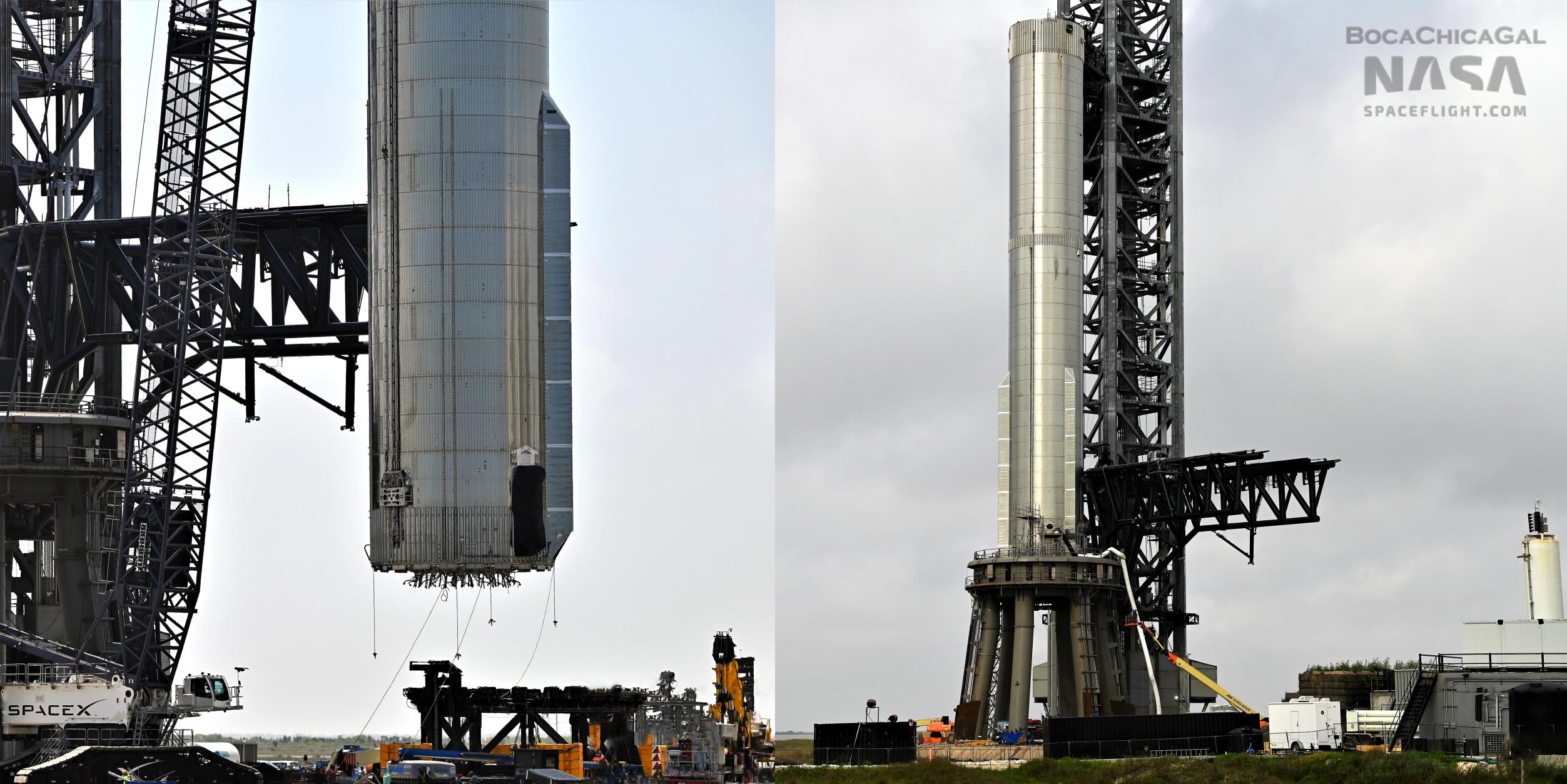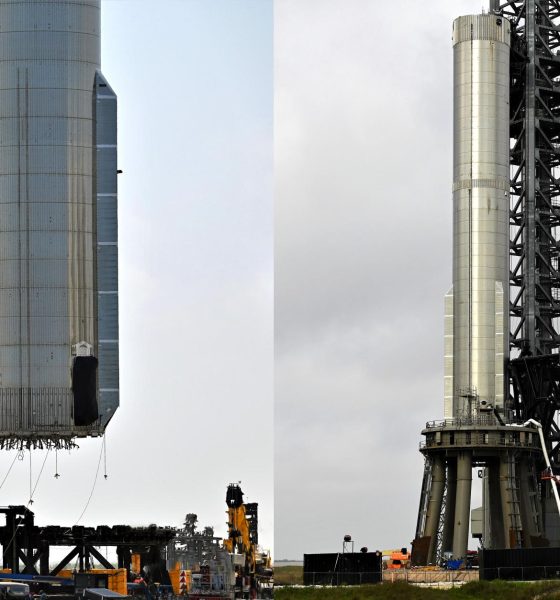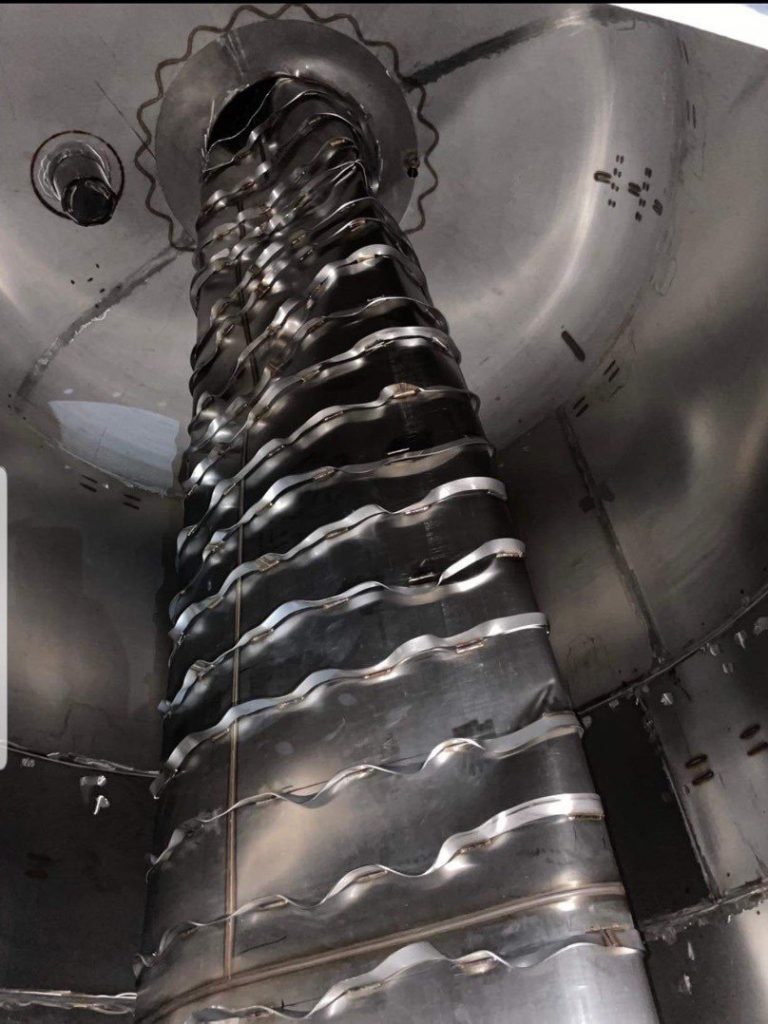

News
SpaceX Super Heavy booster returns to launch pad after major repairs
SpaceX has returned its newest Super Heavy to Starbase’s orbital launch site (OLS) after rapidly repairing damage the booster suffered during its first round of testing.
Super Heavy Booster 7 (B7) left the High Bay it was assembled in for the first time on March 31st and rolled a few miles down the road to nearby Starship launch and test facilities on a set of self-propelled mobile transporters (SPMTs). On April 2nd, the roughly 67-meter-tall (~220 ft; 69m w/ Raptors) rocket was installed on top of Starbase’s lone orbital launch mount (OLM), setting the stage for crucial qualification testing.
The start of that process was exceptionally successful. On April 4th, after a smooth launch mount installation, SpaceX quickly filled Booster 7’s propellant tanks with a relatively benign cryogenic fluid (liquid nitrogen, liquid oxygen, or both) to simulate the thermal and mechanical characteristics of real flammable propellant. Despite the fact that the test marked the first time SpaceX had fully filled a Super Heavy prototype’s tanks, Booster 7 sailed through the ‘cryoproof’ without any obvious issue.
On April 8th, SpaceX moved Super Heavy B7 from the orbital launch mount to a structural test stand that had been installed and modified just a few hundred feet away in the weeks prior. This is where Booster 7’s near-perfect start to qualification testing took a bit of a turn. Booster 7 is only the third full-size Super Heavy prototype SpaceX has tested since July 2021. Like Booster 3 and Booster 4 before it, Booster 7 features some major design changes that ultimately make the prototype a pathfinder, necessitating extensive qualification testing.
To name just a few of the changes, Super Heavy B7 is the first booster fitted with a 33-engine puck and the first finished Starship prototype of any kind designed to use new Raptor V2 engines. With all 33 engines installed and operating a full thrust, Booster 7’s entire structure – and its aft thrust section especially – would be subjected to around 40% more thrust and stress than Booster 4, which indirectly completed structural testing with the help of a sacrificial test tank. Beyond differences in thrust and mechanical stress, Booster 7 is also the first Super Heavy to reach the test stand with secondary ‘header’ tanks meant to store landing propellant.
It’s unclear if those header tanks were fully filled and drained during Booster 7’s cryoproof, but they would not be quite as cooperative during a different kind of cryogenic testing on the structural test stand. The stand SpaceX modified specifically for Super Heavy B7 was outfitted with 13 hydraulic rams to simulate the full thrust of the booster’s central Raptor V2 engines – up to almost 3000 tons (~6.6M lbf) compared to Booster 4’s ~1700 tons (~3.7M lbf) with a smaller cluster of nine engines.
Implosion at the Structural Test Stand
After a few false starts and minor tests on the stand, Booster 7 finally managed some significant testing on April 14th. Judging by the rhythmic shattering of ice that built up on Super Heavy’s tanks, the test stand was able to simulate the thrust of Raptors to some degree and subject the booster to major mechanical stress that was felt from tip to tail. Within a few days, Booster 7 was removed from the test stand and returned to the high bay on April 18th. Around April 21st or 22nd, an image was leaked showing extensive damage inside Booster 7, confirming that the Super Heavy’s test campaign had been forced to end prematurely.

Right away, the damage shown in the photo hinted at an operational failure, meaning that mistakes made by the rocket’s operators may have been more to blame than a possible design flaw. The photo shows a short portion of B7’s liquid methane (LCH4) transfer tube that runs through the booster’s new liquid oxygen (LOx) header tank, which itself sits inside Super Heavy’s main LOx tank at the aft end of the rocket – a tube inside a small tank inside a large tank, in other words. Super Heavy’s LCH4 transfer tube generally does what it says, allowing methane to safely fly down through the main LOx tank and fuel up to 33 Raptor engines. At full thrust, that tube would need to supply around 20 tons (~45,000 lb) of methane per second.
However, on top of merely transferring methane through the oxygen tank, Booster 7 introduced a design change that allows some or all of that tube to change functions and become a header tank mid-flight. That would require a system of valves that could seal off the main LCH4 tank once it was emptied, turning the transfer tube into a sort of giant steel straw filled with enough LCH4 to fuel Super Heavy’s boost-back and landing burns.
The damaged transfer tube in the leaked photo of Booster 7 doesn’t look that unlike what one might expect to see if they sucked through one end of a straw while blocking the other end, collapsing the center. Translated to the scale of Super Heavy, after an otherwise successful day of structural testing, SpaceX operators may have accidentally closed or opened the wrong valves while draining the booster’s transfer tube of liquid oxygen or nitrogen. As the heavy liquid drained from the tube, a lack of pressure equalization could have quickly drawn a vacuum and caused the tube to implode.
On April 29th, a SpaceX fan turned analyst published an analysis that convincingly pinpointed the moment Booster 7’s transfer tube collapsed. Simultaneously, because it showed that the transfer tube likely imploded during detanking, the analysis more or less confirmed the above speculation that the failure had been caused by a degree of operator error or poor test design. Of course, it’s possible that a hardware or software design flaw contributed to or caused the anomaly or that something like a pressure differential in the LOx header tank and LCH4 header tube could also explain the damage, but the accidental formation of a vacuum during detanking is arguably the simplest (obvious) explanation.
After the image of the internal damage leaked, the immediate consensus among fans and close followers was that Booster 7 was beyond repair. Instead, SpaceX appears to have proven those assumptions wrong and somehow managed to repair the upgraded Super Heavy to the point that it was worth testing again less than three weeks after returning to the high bay. On May 6th, B7 was rolled back to the launch site and installed, for the second time, on the orbital launch mount.
Prior to the failure, the general expectation was that SpaceX would begin installing Raptor V2 engines as soon as Booster 7 passed structural testing. It remains to be seen if SpaceX wants to repeat Booster 7’s cryoproof or structural testing to ensure that its quick repairs did the job before proceeding into static fire testing as previously planned. Nonetheless, hope lives on for the Super Heavy prototype and new test windows have been scheduled from 10am to 10pm on May 9th, 10th, and 11th.

News
Tesla FSD fleet is nearing 7 billion total miles, including 2.5 billion city miles
As can be seen on Tesla’s official FSD webpage, vehicles equipped with the system have now navigated over 6.99 billion miles.

Tesla’s Full Self-Driving (Supervised) fleet is closing in on almost 7 billion total miles driven, as per data posted by the company on its official FSD webpage.
These figures hint at the massive scale of data fueling Tesla’s rapid FSD improvements, which have been quite notable as of late.
FSD mileage milestones
As can be seen on Tesla’s official FSD webpage, vehicles equipped with the system have now navigated over 6.99 billion miles. Tesla owner and avid FSD tester Whole Mars Catalog also shared a screenshot indicating that from the nearly 7 billion miles traveled by the FSD fleet, more than 2.5 billion miles were driven inside cities.
City miles are particularly valuable for complex urban scenarios like unprotected turns, pedestrian interactions, and traffic lights. This is also the difference-maker for FSD, as only complex solutions, such as Waymo’s self-driving taxis, operate similarly on inner-city streets. And even then, incidents such as the San Francisco blackouts have proven challenging for sensor-rich vehicles like Waymos.
Tesla’s data edge
Tesla has a number of advantages in the autonomous vehicle sector, one of which is the size of its fleet and the number of vehicles training FSD on real-world roads. Tesla’s nearly 7 billion FSD miles then allow the company to roll out updates that make its vehicles behave like they are being driven by experienced drivers, even if they are operating on their own.
So notable are Tesla’s improvements to FSD that NVIDIA Director of Robotics Jim Fan, after experiencing FSD v14, noted that the system is the first AI that passes what he described as a “Physical Turing Test.”
“Despite knowing exactly how robot learning works, I still find it magical watching the steering wheel turn by itself. First it feels surreal, next it becomes routine. Then, like the smartphone, taking it away actively hurts. This is how humanity gets rewired and glued to god-like technologies,” Fan wrote in a post on X.
News
Tesla starts showing how FSD will change lives in Europe
Local officials tested the system on narrow country roads and were impressed by FSD’s smooth, human-like driving, with some calling the service a game-changer for everyday life in areas that are far from urban centers.

Tesla has launched Europe’s first public shuttle service using Full Self-Driving (Supervised) in the rural Eifelkreis Bitburg-Prüm region of Germany, demonstrating how the technology can restore independence and mobility for people who struggle with limited transport options.
Local officials tested the system on narrow country roads and were impressed by FSD’s smooth, human-like driving, with some calling the service a game-changer for everyday life in areas that are far from urban centers.
Officials see real impact on rural residents
Arzfeld Mayor Johannes Kuhl and District Administrator Andreas Kruppert personally tested the Tesla shuttle service. This allowed them to see just how well FSD navigated winding lanes and rural roads confidently. Kruppert said, “Autonomous driving sounds like science fiction to many, but we simply see here that it works totally well in rural regions too.” Kuhl, for his part, also noted that FSD “feels like a very experienced driver.”
The pilot complements the area’s “Citizen Bus” program, which provides on-demand rides for elderly residents who can no longer drive themselves. Tesla Europe shared a video of a demonstration of the service, highlighting how FSD gives people their freedom back, even in places where public transport is not as prevalent.
What the Ministry for Economic Affairs and Transport says
Rhineland-Palatinate’s Minister Daniela Schmitt supported the project, praising the collaboration that made this “first of its kind in Europe” possible. As per the ministry, the rural rollout for the service shows FSD’s potential beyond major cities, and it delivers tangible benefits like grocery runs, doctor visits, and social connections for isolated residents.
“Reliable and flexible mobility is especially vital in rural areas. With the launch of a shuttle service using self-driving vehicles (FSD supervised) by Tesla in the Eifelkreis Bitburg-Prüm, an innovative pilot project is now getting underway that complements local community bus services. It is the first project of its kind in Europe.
“The result is a real gain for rural mobility: greater accessibility, more flexibility and tangible benefits for everyday life. A strong signal for innovation, cooperation and future-oriented mobility beyond urban centers,” the ministry wrote in a LinkedIn post.
News
Tesla China quietly posts Robotaxi-related job listing
Tesla China is currently seeking a Low Voltage Electrical Engineer to work on circuit board design for the company’s autonomous vehicles.

Tesla has posted a new job listing in Shanghai explicitly tied to its Robotaxi program, fueling speculation that the company is preparing to launch its dedicated autonomous ride-hailing service in China.
As noted in the listing, Tesla China is currently seeking a Low Voltage Electrical Engineer to work on circuit board design for the company’s autonomous vehicles.
Robotaxi-specific role
The listing, which was shared on social media platform X by industry watcher @tslaming, suggested that Tesla China is looking to fill the role urgently. The job listing itself specifically mentions that the person hired for the role will be working on the Low Voltage Hardware team, which would design the circuit boards that would serve as the nervous system of the Robotaxi.
Key tasks for the role, as indicated in the job listing, include collaboration with PCB layout, firmware, mechanical, program management, and validation teams, among other responsibilities. The role is based in Shanghai.
China Robotaxi launch
China represents a massive potential market for robotaxis, with its dense urban centers and supportive policies in select cities. Tesla has limited permission to roll out FSD in the country, though despite this, its vehicles have been hailed as among the best in the market when it comes to autonomous features. So far, at least, it appears that China supports Tesla’s FSD and Robotaxi rollout.
This was hinted at in November, when Tesla brought the Cybercab to the 8th China International Import Expo (CIIE) in Shanghai, marking the first time that the autonomous two-seater was brought to the Asia-Pacific region. The vehicle, despite not having a release date in China, received a significant amount of interest among the event’s attendees.








